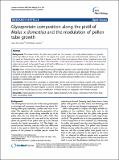Por favor, use este identificador para citar o enlazar a este item:
http://hdl.handle.net/10261/89289COMPARTIR / EXPORTAR:
 SHARE SHARE
 CORE
BASE CORE
BASE
|
|
| Visualizar otros formatos: MARC | Dublin Core | RDF | ORE | MODS | METS | DIDL | DATACITE | |

| Título: | Glycoprotein composition along the pistil of Malus x domestica and the modulation of pollen tube growth |
Autor: | Losada Rodríguez, Juan Manuel CSIC ORCID ; Herrero Romero, María CSIC ORCID | Palabras clave: | Arabinogalactan proteins AGPs Apple Callose Extensins EXTs Malus x domestica Pistil Pollen tube Style Transmitting tissue |
Fecha de publicación: | 3-ene-2014 | Editor: | BioMed Central | Citación: | BMC Plant Biology 14: 1 (2014) | Resumen: | [Background] The characteristics of pollen tube growth are not constant, but display distinct patterns of growth within the different tissues of the pistil. In the stigma, the growth rate is slow and autotrophic, whereas in the style, it is rapid and heterotrophic. Very little is known about the interactions between these distinct maternal tissues and the traversing pollen tube and the role of this interaction on the observed metabolism. In this work we characterise pollen tube growth in the apple flower and look for differences in glycoprotein epitope localization between two different maternal tissues, the stigma and the style. [Results] While immunocytochemically-detected arabinogalactan proteins were present at high levels in the stigma, they were not detected in the transmitting tissue of the style, where extensins were abundant. Whereas extensins remained at high levels in unpollinated pistils, they were no longer present in the style following pollen tube passage. Similarily, while abundant in unpollinated styles, insoluble polysaccharides such as β-glucans, were depleted in pollinated pistils. [Conclusions] The switch from autotropic to heterotrophic pollen tube growth correlates spatially with a change of glycoprotein epitopes between the stigma and the style. The depletion of extensins and polysaccharides following pollen tube passage in the style suggest a possible contribution to the acceleration of heterotrophic pollen tube growth, which would imply an active contribution of female tissues on prezygotic male–female crosstalk. |
Versión del editor: | http://dx.doi.org/10.1186/1471-2229-14-1 | URI: | http://hdl.handle.net/10261/89289 | DOI: | 10.1186/1471-2229-14-1 | ISSN: | 1471-2229 |
| Aparece en las colecciones: | (EEAD) Artículos |
Ficheros en este ítem:
| Fichero | Descripción | Tamaño | Formato | |
|---|---|---|---|---|
| 1471-2229-14-1.xml | 92,02 kB | XML | Visualizar/Abrir | |
| 1471-2229-14-1.pdf | 5,4 MB | Adobe PDF |  Visualizar/Abrir |
CORE Recommender
PubMed Central
Citations
12
checked on 26-abr-2024
SCOPUSTM
Citations
34
checked on 23-abr-2024
WEB OF SCIENCETM
Citations
36
checked on 22-feb-2024
Page view(s)
467
checked on 24-abr-2024
Download(s)
515
checked on 24-abr-2024

